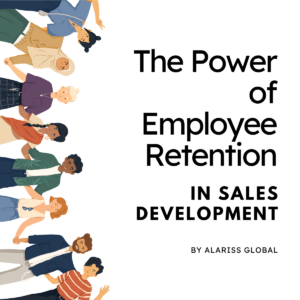Blog
The Power of Employee Retention in Sales Development

July 6, 2023
Employee retention is a critical factor in the success of any organization. When it comes to sales development teams, retaining talented and motivated individuals is essential for maintaining productivity, driving revenue growth, and building long-term customer relationships. In this blog, we not only explore the latest trends and dynamics in sales development but also emphasize the importance of employee retention in this field. By understanding the factors influencing retention rates and implementing effective strategies, companies can create a stable and high-performing sales development team. Let’s delve into the data and insights that shed light on this crucial aspect.
As the landscape of sales development continues to evolve, it is important to understand the trends and dynamics shaping this field. Let’s delve into recent data and findings that provide valuable insights into the world of sales development.
Required Experience at Hire
In the past decade, there has been a significant shift in the required experience when hiring for sales development roles. Surprisingly, the average required experience has been gradually decreasing, reaching an all-time low of 1.2 years in 2020. Despite the widespread layoffs experienced in 2020, and 2023 hiring managers did not move upstream in terms of required experience, debunking the assumption that they would seek more experienced candidates. Alariss’s experience at hire sheds light on the evolving expectations of hiring managers, helping companies align their recruitment strategies with industry trends. By leveraging our data, we help organizations make informed decisions when it comes to determining the appropriate level of experience needed for sales development roles.
Ramp Time and Productivity
On average, it takes around 3.1 months for new sales development representatives (SDRs) to ramp up and achieve full productivity. This consistent ramp time aligns with previous findings from 2018. Interestingly, high-growth companies have reported slightly faster ramp times compared to their slower-growing counterparts. This underscores the importance of efficiently onboarding and training new SDRs to maximize their productivity within a shorter timeframe. Our findings on ramp time and productivity enable companies to streamline their onboarding and training processes. Understanding the average time it takes for new hires to reach full productivity allows organizations to set realistic expectations and allocate resources effectively to support the ramp-up period.
Tenure and SDR to AE Promotions
While average tenure increased in 2020, sitting at 1.8 years, SDR to Account Executive (AE) promotions experienced a slowdown. Data shows that the months spent as an SDR before being promoted to an AE role increased by 28% for the class of 2019 compared to the class of 2018. This shift indicates a shift away from the rapid promotion model seen in previous years, emphasizing the need to focus on building engaging and rewarding career paths for SDRs. At Alariss, we understand the importance of career development and growth opportunities within sales development teams. By recognizing the shifts in promotion patterns, organizations can design engaging and rewarding career paths that incentivize talented individuals to stay and grow within the company.
Career Paths and Opportunities
Most companies surveyed offer some form of career path for SDRs, with more than half providing two or more options. These career paths range from SDR-to-AE promotions to step-based promotions and opportunities across different teams. Notably, the prevalence of SDR-to-AE promotion paths varies significantly based on the average sales price (ASP), with lower ASP companies offering higher promotion rates.
Attrition Rates
Since the tumultuous year of 2020 the industry has witnessed a significant impact on the job market, the total average attrition rate for sales development roles experienced a sharp decline. The decrease in attrition was primarily driven by a substantial drop in voluntary turnover (resignations). As the job market stabilizes and rebounds, we anticipate attrition rates to return to normal levels. At Alariss, we are passionate about researching and consulting in the field of sales development, and one area we focus on is attrition rates. Our expertise allows us to provide valuable insights into the dynamics of attrition and its impact on organizations. By delving into industry trends and benchmarks, we help companies understand the underlying causes of attrition and develop effective strategies to mitigate talent loss.
The insights shared above offer valuable observations on the trends and changes within the sales development landscape. From adjustments in required experience to shifts in promotion patterns, these findings shed light on the dynamics of sales development teams. By understanding these trends, companies can adapt their hiring strategies, refine their onboarding processes, and create rewarding career paths for SDRs. As the sales development field continues to evolve, staying informed and adapting to the changing landscape is key to driving success and achieving sales targets.
Collaborating with Alariss can provide companies with the necessary insights and tools to adapt to the changing landscape of sales development, improve their employee retention rates, and ultimately drive success in achieving their sales targets. Book a free demo with them to get insights of their research which serve as a valuable resource for organizations seeking to optimize their sales development teams and stay ahead in a competitive market.





